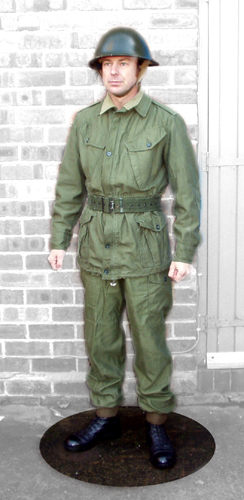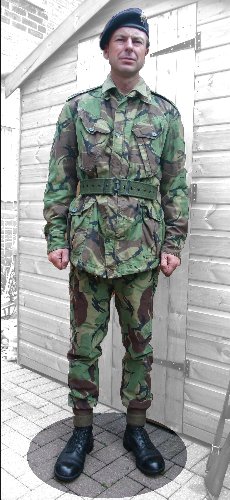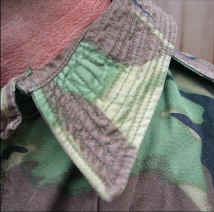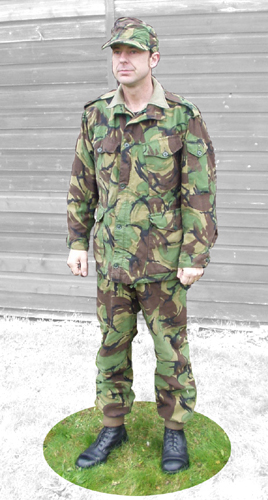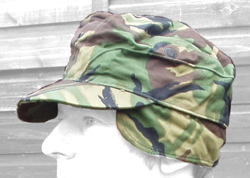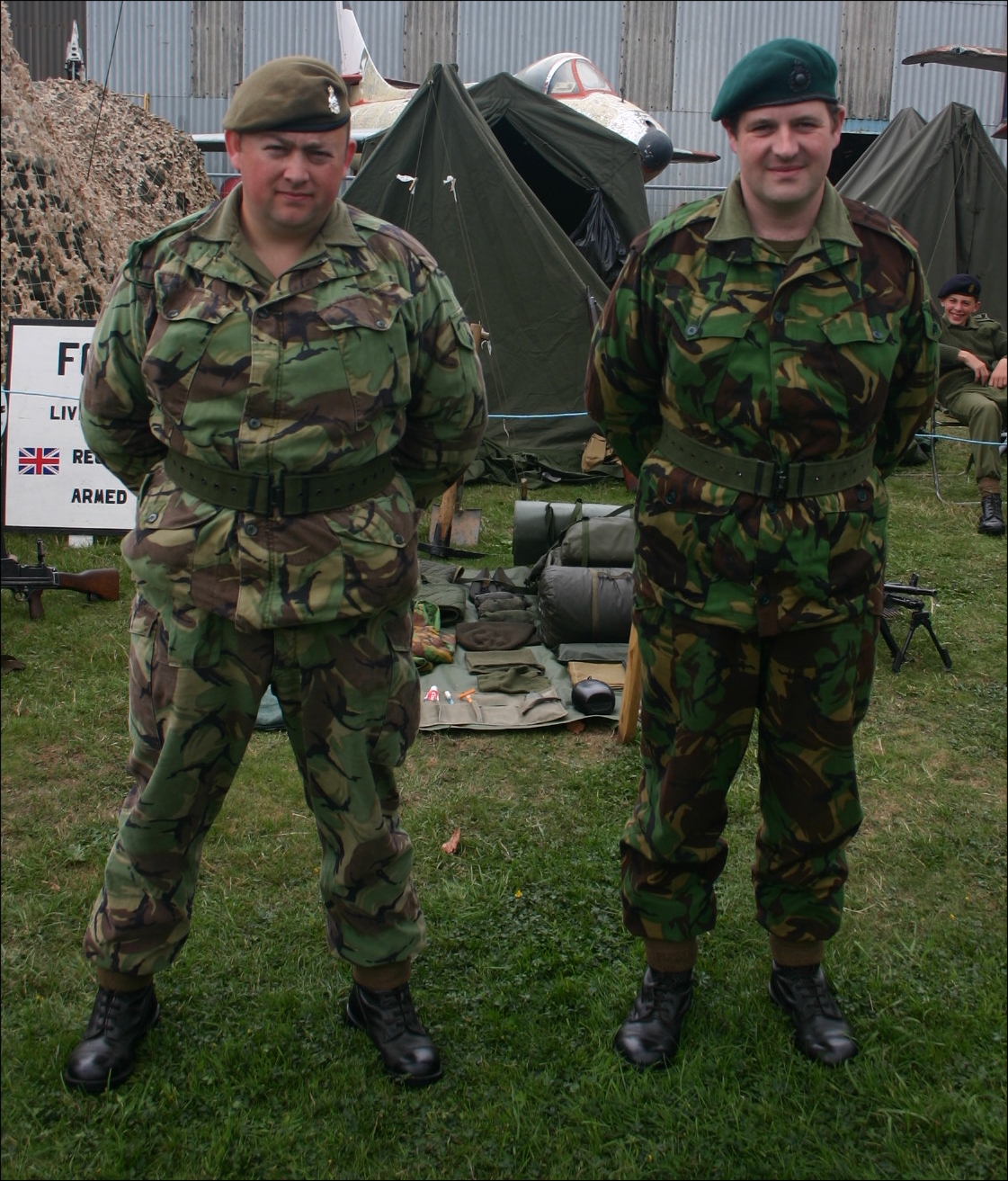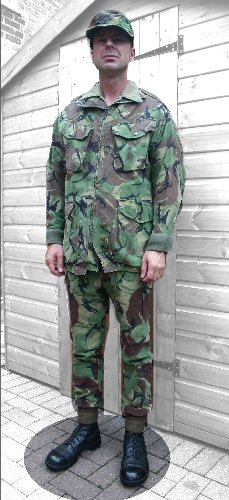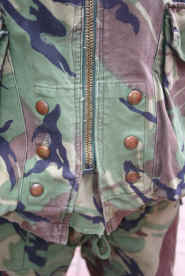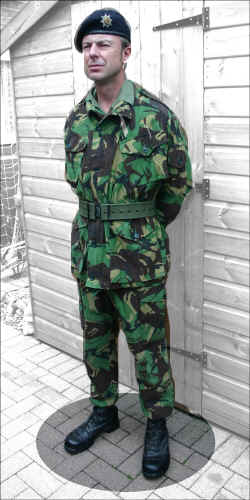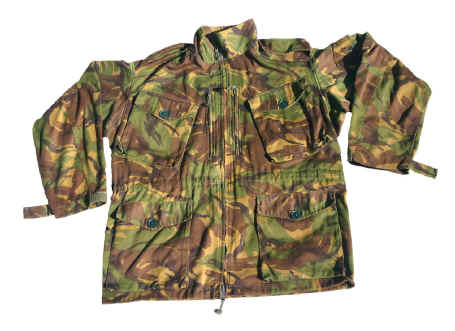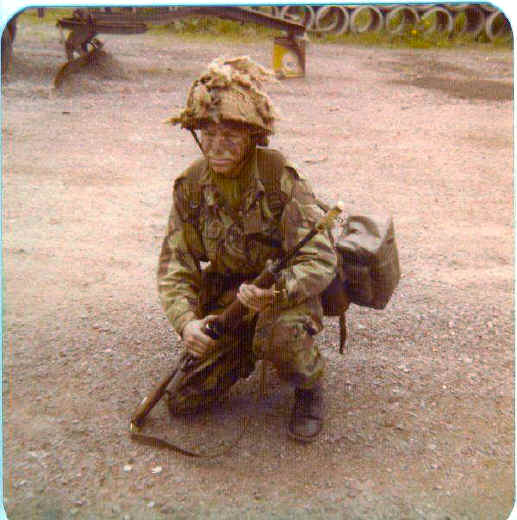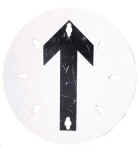
|
F80 Pages |
|
F80 Resources |
|
Deployments |
|
Uniforms |
|
NBC |
|
Events |
|
Information and photographs on up-coming and past events can now be found on our Face book page. |
|
Contact F80 |
|
You can contact Forces 80 HQ either through Facebook or via email at: info@forces80.com |
|
|
COMBAT UNIFORMS OF THE 1980's (A Beginners Guide)
Part 1DPM Uniforms

Preface
Identifying the pattern of uniforms are not as straight forward as it seems. Not only is there the official designation and but also the collectors/Surplus market designations. In the face of a lack of official information the latter designations is an identifying designation given over the years by members of the trade and public in an effort to describe the type of uniform that they are looking for or actually have.
Below is an attempt at identifying the various patterns of uniform. Although it may not be as correct as I would have liked it to be, it is a starters guide and nothing more.
Having been told by various people "You can not identify a uniform by its pattern or coloring and that to identify a uniform by a pattern designation is wholly incorrect" and that "DPM is DPM", to a certain extent I have to agree with this and yet I also strongly disagree with these statements. At first glance "DPM is DPM" but with a little knowledge and a trained eye you will slowly notice the differences and will become able to tell one DPM pattern from another .
But there is a difference, you will notice it in the cut of the cloth, the materials used and the colouring of the DPM. Although the latter can cause problems between identifying at a distant tcertain late production runs or crossover DPM patterns. Yet there is a fundamental difference between the cut of the '68 pattern combats and the cut of the '85 pattern combats
One of the major problems of wearing DPM is that for those that are not aware of the difference in the patterns and styles, still think you are wearing current issue clothing and are a serving soldiers, not realizing that in fact you are wearing uniforms designed over 50 years ago.
Once you have mastered the various shades and patterns you will more than likely walk down a street or even around a show, saying to your self " 68 pattern... 85 pattern... Nope that's wrong, that's current... Yup that's 68 pattern" It comes automatically. And when you see someone wearing a very good condition '68 pattern Windproof in a large size you will want to throttle them for it and will curse them under your breath.So after a while you will spot a '68 pattern item mixed in with '85 pattern from well over 100 yards.
Below I have used a common collectors identification (In Italics) along side the Official identification which is normally used on the labels. This may seem confusing at first but you will soon learn the differences and can then determine what you wish to use.
Thanks and good hunting
Development of the Temperate Uniform
From experiences learnt during the Korean War it was decided to develop a new combat uniform more suited to the changes in weather encountered. The new design, heavily influenced by the American war time M1943 uniform was a break from the traditional heavy wool uniform of the 1930's. The new design was called the 1952 Pattern Combats made out of an Olive green Sateen material, consisted of a Smock, Trousers and hood. With the end of National Service in sight the Army could now afford to supply its smaller forces with a new uniform and after trials of the 1952 Pattern it was decided to make the uniform out of Cotton. With a few minor changes; the new combat uniform was known as the 1960 Pattern Combats.
In about 1966 it seems that the idea for a new disruptive pattern material (DPM) may have been conceived. The basic cut of the cloth was the same as the '60 pattern Combats but made out of the new DPM material. These are known rightly or wrongly by collectors as the '66 pattern DPM Combats. It seems that they are more than likely an interim production run of the '68 pattern combats where manufacturing processes had not fully changed over from the 60 pattern to the new 68 pattern.
Further development resulted in the 1968 pattern DPM Combat suit, which was based on the earlier '60 pattern Combats and is similar in appearance albeit in DPM. Trails were carried out and the '68 pattern was accepted for common issue from 1972 onwards. This was a leap for the British army who had up to then only issued camouflaged Dennison Combat Smocks to the Parachute Regiment and other specialized units, although some regulars sought the Dennison smock via private means.
The '68 Pattern DPM consisted of a four colour pattern of Green, Brown, Ochre and Black with the Green having a slightly darker green outline/border also DPM colours tend to differ slightly depending on the manufacturer, for example items made in Northern Ireland can be slightly browner in colour.
In or around 1975 some changes to the basic cut of the '68 pattern combats resulted in a '75 pattern and is to all other purposes a variation of the '68 pattern so was never reclassified or referred to as '75 pattern.
The '68 Pattern was a heavy uniform, being twin lined and when wet tended to take a long time to dry out. The following uniform types were developed in similar DPM - Temperate, Artic and Tropical.
By the mid 1980's with the lessons learnt from the 1982 Falklands Conflict it was decided to develop a new uniform which would be more soldier friendly, with larger pockets, faster drying materials and was lighter that became known as '85 pattern and was issued for common use from 1986 onwards. But some habits died hard and some still preferred the '68 pattern because of its durability. It was common to see '68 and '85 pattern being worn together in a mix and match way. In the late 1980's a 1990 pattern was developed which was based on the '85 pattern but was supposed to be more robust, but again this did not solve the problem of the troops mixing the various patterns. The introduction of Soldier '95 combats resolved the issue of the mix and match and is very much the 1st pattern of the modern day combats which uses a layer system.Suggested uniform time line
Uniform, Webbing, Weapon 1978 1979 1980 1981 1982 1983 1984 1985 1986 1987 1988 1989 1968 pattern DPM Y Y Y Y Y Y Y Y Y Y Y Y 1984/85 pattern DPM - - - - - - T T Y Y Y Y DMS, Boots, Ankle & Puttees Y Y Y Y Y Y Y Y Y - - - DMS, Boots, High Leg - - - - T T Y Y Y Y Y Y Mk IV/V Helmet Y Y Y Y Y Y Y Y Y Y Y Y Mk VI Helmet - - - - T T Y Y Y Y Y Y '58 Pattern Webbing Y Y Y Y Y Y Y Y Y Y Y Y PLCE Webbing (Press Stud) - - - - - - T T T T - - PLCE Webbing (early production) - - - - - - - - - T T Y SLR Y Y Y Y Y Y Y Y Y Y Y Y SA80 - - - - - T T Y Y Y Y Y Y = In General Service, alocated to Front Line units first
T = Trials and not on general issue
'60 Pattern Combat Suit (Olive)
SMOCK, COMBAT 1960 Pattern
TROUSERS, COMBAT 1960 Pattern
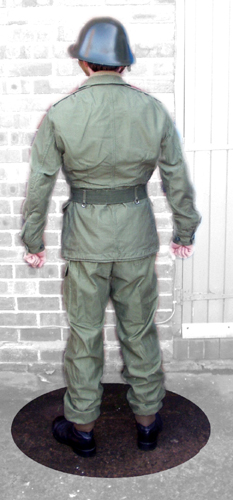
The '60 pattern 'Olive' Combats were designed to replace the woolen Khaki Serge battle dress of 1930's design. It consisted of an Combat smock and trousers in a Olive cotton material which was twin lined with a lighter material also in Olive. The Trousers were based on the Cavalry design so came above the waist line and was designed to be used in conjunction with braces. There was no hood designed for use with the '60 Pattern Combat so the '52 Pattern Hood was issued.
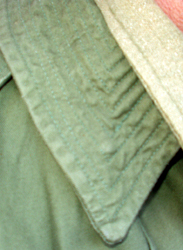
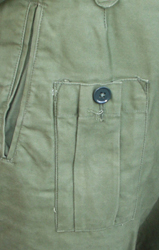
NSN's
Size Smock Trousers 1 8405-99-9733931 8405-99-1277329 2 8405-99-9733932 8405-99-1277330 3 8405-99-9733933 8405-99-1277331 4 8405-99-9733934 8405-99-1277332 5 8405-99-9733935 8405-99-1277333 6 8405-99-9733936 8405-99-1277334 7 8405-99-9733937 8405-99-1277335 8 8405-99-973938 8405-99-1277336 9 8405-99-9733939 8405-99-1277337 Special measure 8405-99-9733940 8405-99-1277338
'66 pattern Combats (DPM)
SMOCK, COMBAT (1960 Pattern)
TROUSERS, COMBAT (1960 Pattern)
By 1966 further research produced a camouflaged version of the '60 pattern Combat suit in disruptive pattern (DP) material to enable the soldier to blend in with his surroundings . The combat jacket was exactly the same cut as the '60 pattern combat suit and included the same stitching of the collar and twin lining. This pattern of combats is commonly referred to as the '66 pattern DPM Combat suit although its correct designation is 'Combats (1960 Pattern)'.
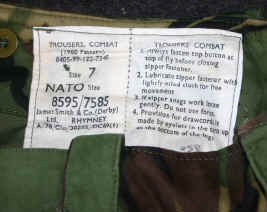
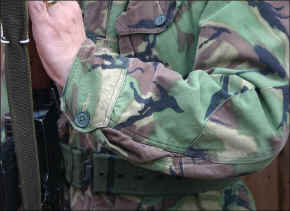
Here are the basics for spotting a '66 pattern DPM uniform.
1. The jacket has a twin lining that is a mix of material in olive and brown Poplin material. 2. The jacket has a stitched collar and re-enforced elbows. 3. The trousers are lined in olive or brown material. 4. The Label will only have a Size sizing.NSN's
Size Smock Trousers 1 8405-99-1277329 8405-99-1277339 2 8405-99-1277330 8405-99-1277340 3 8405-99-1277331 8405-99-1277341 4 8405-99-1277332 8405-99-1277342 5 8405-99-1277333 8405-99-1277343 6 8405-99-1277334 8405-99-1277344 7 8405-99-1277335 8405-99-1277345 8 8405-99-1277336 8405-99-1277346 9 8405-99-1277337 8405-99-1277347 Special measure 8405-99-1277338 8405-99-1277348
'68 pattern Combat Suit (DPM)
SMOCK, MAN'S COMBAT (1968 Pattern)
TROUSERS, MEN'S COMBAT (1968 Pattern)
HOOD, COLD WEATHER (COMBAT, DPM)
Further development of the '66 pattern DPM lead to the 1968 pattern Combat Suit. This was largely based around the 60 pattern with some minor improvements. After further trials the '68 pattern DPM was accepted for common issue from 1972 onwards. In 1975 the DPM coloring was subtly changed - More I suspect due to advances in dying techniques and newer materials - but as nothing else was changed these '75 pattern were never relabeled as such or so we thought (see below), so fall under the '68 pattern and are very difficult to spot.
A Temperate set of '68 pattern consists of Jacket, trousers, Hood and Cap. Tropical and Artic clothing was also produced using similar DPM patterns and are also referred to as '68 pattern. Depending on the time of year, under the Jacket was worn a Shirt, a woolen jumper and if needed to, a sleeves less quilted jacket Liner.
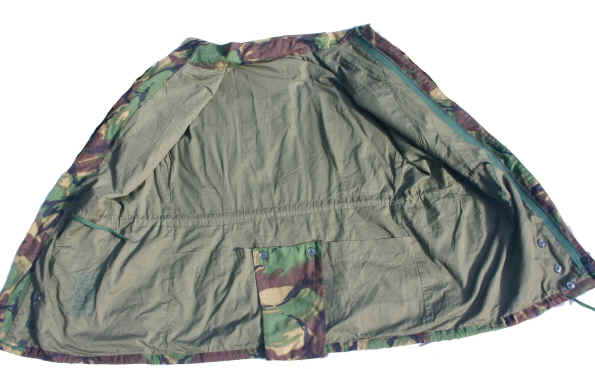
The inside of the '68 Jacket is fully lined in Olive. It has a inside pocket on the left chest large enough to take an SLR Magazine and a pocket across the back below the waist. Also note the crotch flap.'68 pattern Combats were produced by numerous manufacturers and as a result slight colour variations of the DPM can be found. For example Combats made in Northern Ireland are slightly browner in appearances.
The Jackets label has instructions on keeping warm and for additional warmth the jacket is fitted with a crotch flap. This was to provide the Soldier in cold weather some form of extra warmth to the crotch area and was added to prevent the smock from rising during helicopter operations, So do not be fooled, Para Jackets commonly have press studs instead of buttons holding the flap in place, but sometimes squaddies will modify things. It has been known that unscrupulous dealers to have claimed ordinary combat jackets as being Para issue because of this crotch flap and have hiked up the prices.
Here are the basics for spotting a '68 pattern uniform.
1. The jacket has a twin lining of Olive Poplin material . 2. The jacket cuffs are fixed with buttons and the jacket pockets are flat. 3. The trousers have the shell dressing pocket as on the earlier '60 pattern, and are twined lined with an Olive material down to below the Knee. 4. Early garments will have Size sizing and later ones will have NATO sizing..
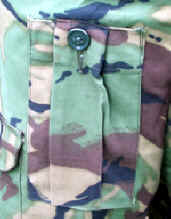
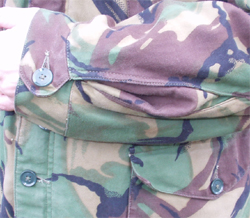
NSN's
The 68 Pattern Combats were issued from 1972 to the late 1980's. Over this period the uniform either as a result of slight alterations or better manufacturing processes resulted in at least 4 different NSN's if not more. Below is an example of one of these set of numbers.
Size Smock Trousers Hood 1 8405-99-1321821 8405-99-1321831 8415-99-132-2048 2 8405-99-1321822 8405-99-1321832 8415-99-132-204 3 8405-99-1321823 8405-99-1321833 4 8405-99-1321824 8405-99-1321834 5 8405-99-1321825 8405-99-1321835 6 8405-99-1321826 8405-99-1321836 7 8405-99-1321827 8405-99-1321837 8 8405-99-1321828 8405-99-1321838 9 8405-99-1321829 8405-99-1321839 Special measure 8405-99-1321830 8405-99-1321840
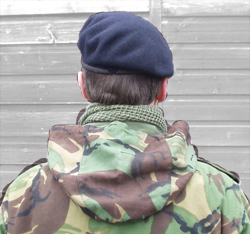
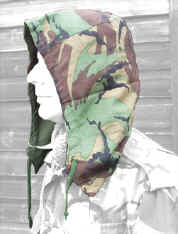
The optional Hood is fitted via a button at the center of the jackets collar at the nape of the neck and via the epaulet buttons.
At the same time a Cap GS was issued, a General purpose cap issued to all services and was often referred to as "Crow Hat". This cap was issued until the late 90's when Soldier 95 eventually became available in large quantities.
Late Production '68 pattern Combats
At some point after 1975 the design of the '68 pattern was subtly changed. Although the designation did not. Identifying these garments has not always been easy until someone pointed out some minor differences to the uniforms that made us all go scurrying to our collections.
On the Left is an Early Pattern and on the Right is a Late Pattern '68 Jacket and Trousers.The first major give away is on the label. The NSN designation code changed from 8405 to 8415. The second but not always a main identifier is the colour of the DPM, it is a Stronger often Darker colour due to new dying techniques. As for the Trousers, the main difference are the belt loops. These went from having on the original design, 5 loops to; on the late design, 6 loops.
'68 Pattern Para Smock
Smock, Mans, Parachutist
In around 1972 a Para Smock was also made which was developed around the Denison Smock of War Time fame. This smock is made from the '68 pattern in DPM material and is common referred to as the '68 pattern or '72 pattern.
Unlike the standard 68 pattern smock It has 4 billowing pockets, 2 on the chest and 2 on the hips each fastened with brass press studs which were used to prevent the lines from the parachute snagging on the buttons.
It is also fitted with a Crutch flap which was held in place on the outside rear of the smock with two brass studs. This was passed through the legs and held in place to the front of the smock by press studs. This was done to prevent the smock rising during a Parachute drop and Helicopter Operations, It also was designed to give extra warmth to the groin area if needed. (Please note that the standard '68 Pattern Combat Jacket also has this Flap)
At the end of the sleeves was a woolen sock style cuff again to prevent the parachute lines snagging and to provide additional warmth.
Here are the basics for spotting a '68 pattern PARA Smock.
1. The jacket has a twin lining of Olive Poplin material. 2. The jacket cuffs are of a Woolen Sock style and the pockets are fixed by Brass press studs. 3. The crotch flap is attached to the rear of the smock by press studs. 4. The Label will only have a Size sizing.
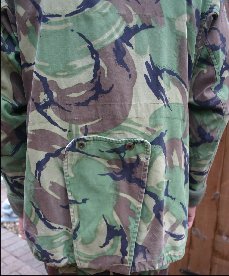
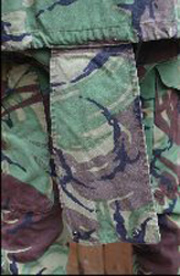
'85 pattern DPM Combats
SMOCK, COMBAT DPM
TROUSERS, COMBAT DPM
This pattern was introduced in 1984, but is commonly know as '85 pattern. The shortcomings of the '68 pattern came to light during the 1982 Falklands Conflict where the '68 pattern, which was originally designed with the weather conditions of the plains of Germany in mind, was unsuitable for the prolonged exposure to the varied weather conditions found in the Falklands.
From these lessons it was decided to develop new uniforms and equipment which resulted in a new '85 pattern DPM Combats which were designed to be lighter, faster drying and more soldier friendly but failed in that it was not robust enough and ripped or fell apart all too easily.
The use of modern materials such as Velcro did not go down too well with some soldiers and the result being that soldiers reverted back to the '68 pattern due to its robustness and as a result, a mix match, rag tag appearance developed amongst the troops.
Here are the basics for spotting a '85 pattern uniform.
1. The jacket has a twin lining of DPM material across the shoulders and has a Field dressing pocket on the right sleeve. 2. The jacket cuffs are fixed using Velcro and the jacket pockets are bellowed. 3. The trousers do not have the shell dressing pocket as on the earlier '68 pattern, but are twined lined with an Olive material down to the Knee. 4. The Label will only have a NATO sizing.
'85 Pattern Para Smock
INSERT TEXT HERE
'90 pattern DPM Combats
SMOCK, COMBAT (Temperate DPM)
TROUSERS, COMBAT (Temperate DPM)Complaints about the '85 pattern Combats resulted in a newly designed version that was designed around 1990 and issued from roughly 1992 to 1994. This new uniform was supposed to fix the durability problem which it did in fashion but it still resulted in the mix and match approach to wearing uniforms as it was only issued to replace worn out kit.
This Rag Tag look to the British army continued until the introduction of the 1995 pattern uniform known as Soldier 95 which used all the modern materials available such as Gortex, Ripstop and Fleece and used a layer approach. Again the colour of the DPM changed to a more olive colour very similar to early DPM but brighter.
Further design of the S95uniform resulted in the introduction of the Soldier 2000 range.
'90 Pattern Combat Jacket in "Tea Leaf" DPM said to designed for use in Bosnia.
The easiest way to distinguish a '90 pattern jacket form a '85 pattern is that the jacket will have an extra Zip up pocket , running vertically either side of the main Zip.
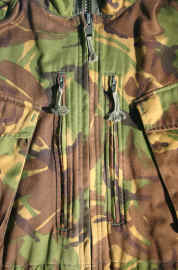
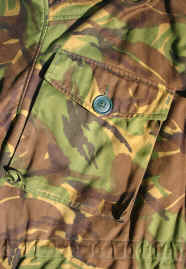
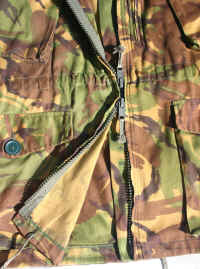
A Note on DPM Colours
Period photographs can also not give true colours due to Processing methods.The Main issue with identifying DPM is not just the cut of the cloth, but also the colours. DPM colours fade with the passing of time from wear and tear to constant washing. But that is not the only reason for different DPM colours. DPM was not made by just one manufacturer, but several different manufacturers throughout the United Kingdom. And each of these manufacturers had their own dying techniques and their own take on the DPM colours. As you can see from the pictures above there is a few different shades, and below are some more. Another thing is to note that you can not accuratly capture a colour through a photograph, its all down to light and shade, Exposure, and Development processes; and in the modern age, Contrast, Colour corrections, resolution, and the settings of your monitor or tablet/phone screens.
Two Variations on a theme, Both '68 Pattern Jackets, Two different Manufacturers.
Again, Both are '85 Pattern Combat Smocks, Two different manufacturers
İForces80 2019

